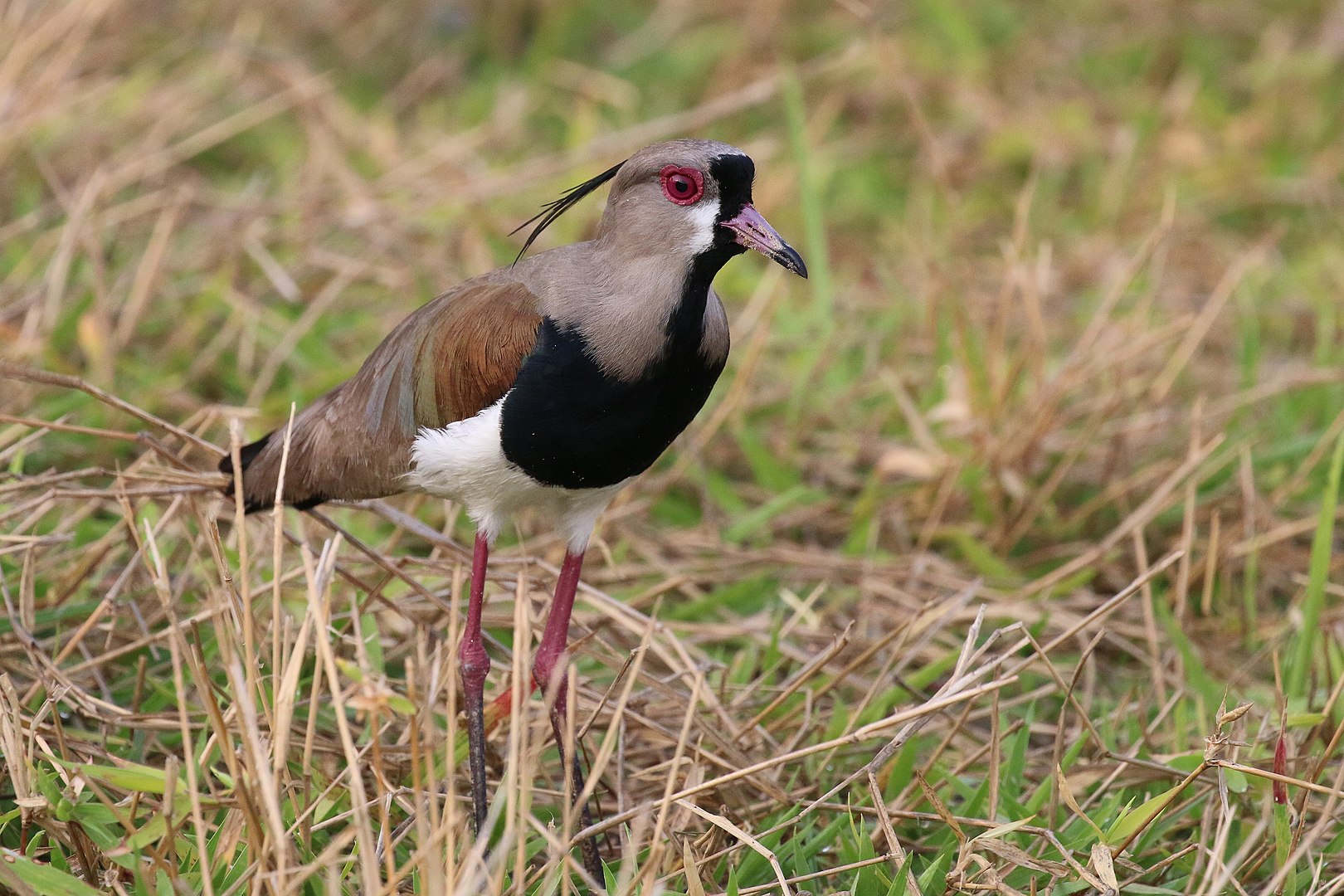The Southern lapwing is a conspicuous inhabitant of grasslands and pastures. It is a common and widespread resident throughout South America (Guyana), except in densely forested regions (e.g. most of the Amazon), the higher parts of the Andes and the arid coast of a large part of western South America. This bird is particularly common in the basin of the Rio de la Plata. It has also been spreading through Central America in recent years. Southern Lapwings feed mainly on insects, as well as small fish and aquatic invertebrates. Further, these large plovers are well adapted to human disturbance and are increasing their range in response to deforestation and cultivation.
Features Of The Southern Lapwing
- Head – The head is particularly striking; mainly grey with a black forehead and throat patch extending onto the black breast. A white border separates the black of the face from the grey of the head and crest.
- Eyes, Bill & Feet – It has large eyes, long legs and pink feet. The small bill is pink with a black tip.
- Upperparts – The upperparts are mainly brownish grey, with a bronze glossing on the shoulders.
- Underparts – The rest of the underparts are white. It is equipped with red bony extensions under the wings (spurs), used to intimidate foes and fight birds of prey.
- Length & Weight – It is 32 to 38 cm (13 to 15 in) in length and weighs approximately 250 to 425 g (8.8 to 15.0 oz).
- Wing & Tail – During its slow flapping flight, the southern lapwing shows a broad white wing bar separating the grey-brown of the back and wing coverts from the black flight feathers. The rump is white and the tail black.
- Call – The Southern lapwing is very noisy, giving penetrating, loud calls similar to harsh barking “tee-ow”. We can also hear a short “pi-up” often repeated. This bird also gives a loud, harsh “parp-peup-peup-peup” when flushed. The call is also very loud and harsh sounding like keek-keek-keek.
Tip: The Southern lapwing is the only crested wader in South America.
Scientific Classification Of The Southern Lapwing
Southern Lapwing – Vanellus chilensis [Scientific name]
- Kingdom: Animalia
- Phylum: Chordata
- Class: Aves
- Order: Charadriiformes
- Family: Charadriidae
- Genus: Vanellus
- Species: V. chilensis
There are four subspecies:
- V.c. cayennensis from N South America and N Amazon. This race has little black on upper breast, whiter face, and rather cinnamon-brown head and neck than blue-grey.
- V.c. lampronotus from S Amazon to N Chile and N Argentina. It has little white on forehead and more on throat. Head and neck are brown-grey.
- V.c. chilensis from Central Chile and Argentina.
- V.c. fretensis from S Chile and S Argentina. This one is similar to nominate race, but smaller.
Habitat & Diet Of The Southern Lapwing
This is a lapwing of lake and river banks or open grassland. It has benefited from the extension of the latter habitat through widespread cattle ranching. When nesting in the vicinity of airports, it poses a threat to the safety of aerial traffic. Its food is mainly insects, earthworm and other small invertebrates, hunted using a run-and-wait technique mainly at night, often in flocks. It also hunts in shallow water where it catches small fishes and insect larvae disturbed by foot-trembling. Adults feed the chicks with earthworms.
Reproduction Of The Southern Lapwing
The southern lapwing breeds on grassland and sometimes ploughed fields, and has an aerobatic flapping display flight. It lays 2–3 (rarely 4) olive-brown eggs in a bare ground scrape. She incubates during 23-25 days. The nest and young are defended noisily and aggressively against all intruders (including humans) by means of threats, vocalizations and low flights. After the breeding season it disperses into wetlands and seasonally-flooded tropical grassland. They are seen in small flocks outside the breeding season, but sometimes up to 200 birds. During the breeding season, the Southern lapwing is territorial and some disputes often occur. The male defends the area by giving loud, persistent calls. Threat displays consist in upright postures with stretched out neck. In more intense confrontation, the birds can use the carpal spurs as weapons.
Southern Lapwing In Guyana
Southern lapwings are raucous, conspicuous shorebirds as you would have learned while reading this article. They have a distinctive color pattern with black breast, white belly, gray head, and bronzy shoulder. Their wings are boldly patterned in flight. They are often in pairs or small flocks in open habitats, usually near water but also in dry pastures. Their loud grating call is a good clue to its presence. This bird is widespread throughout its large range. The species takes advantage from deforestation and agriculture, and expends its habitat, even close to human habitations. Thankfully, the species is not threatened at this moment. We are privileged to have these beautiful birds in Guyana, their dramatic behaviors add to the joy and excitement of bird watching.
Article References:
- https://neotropical.birds.cornell.edu/portal/species/overview?p_p_spp=144596
- https://ebird.org/species/soulap1
- http://www.oiseaux-birds.com/card-southern-lapwing.html
- https://en.wikipedia.org/wiki/Southern_lapwing







